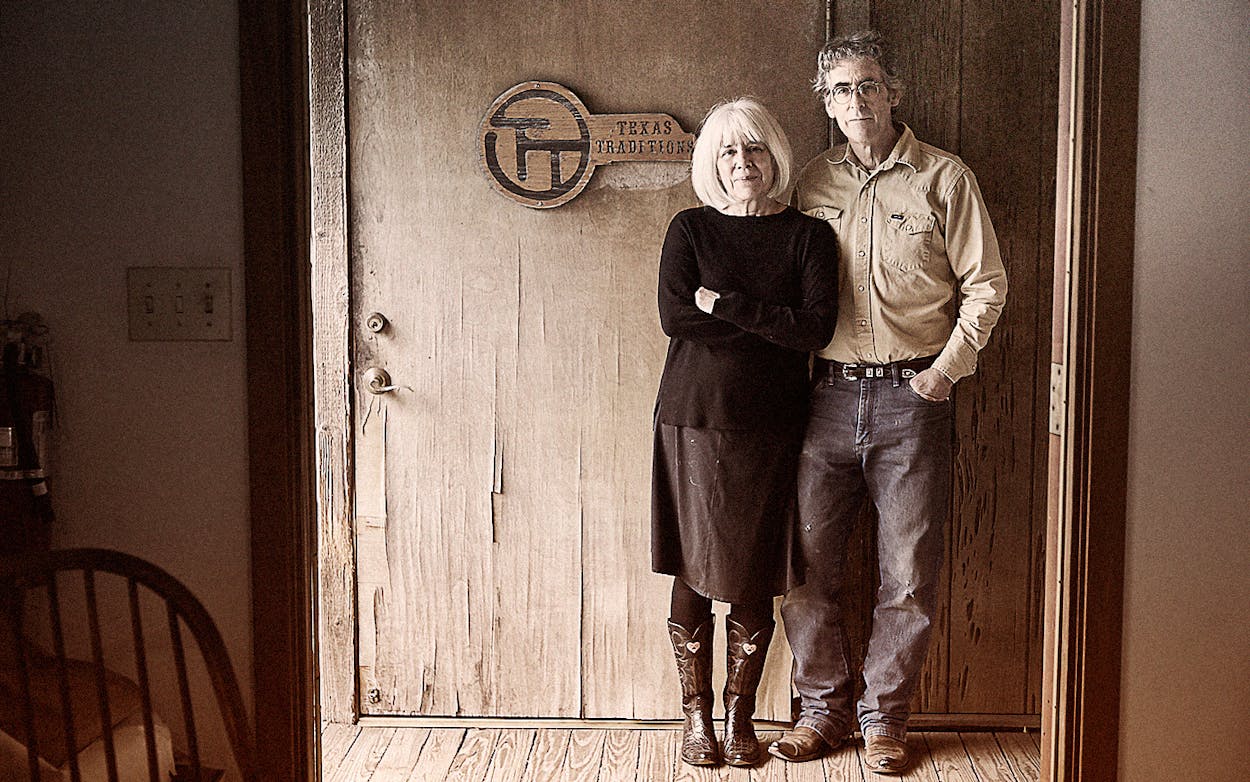Subscribe
In 1985, singer-songwriter Guy Clark took Lyle Lovett to visit Texas Traditions—the South Austin shop then run by Charlie Dunn, a fifth-generation bootmaker immortalized in Jerry Jeff Walker’s 1972 song titled with his name. It would be a few more years before Lovett could afford a pair of custom Texas Traditions boots of his own. By then, Dunn had retired and passed the business to Lee Miller, who’d apprenticed nine years under Dunn, and Lee’s wife, Carrlyn. “Lee and Carrlyn made me my first pair of custom boots in 1989,” Lovett wrote in an essay about the traditions and deeper meanings of boots in his life for the December issue of Texas Monthly. “Charlie was famous for firing people, so I asked Lee one day, ‘How did you survive Charlie? How did Charlie never fire you?’ And Lee said, ‘Oh, Charlie fired me every day. I just kept coming back.’”
After more than thirty years at the helm of Texas Traditions, Lee and Carrlyn Miller have built their own reputation for turning out custom boots with refined style and an almost maniacal attention to sizing. There’s a four-year waiting list for their boots, which start at a base price of $2,900 and can run significantly higher. They continue to offer designs Dunn made famous, like the “pinched rose” or a name stitched in a mirror image, and the Millers are also continuing Dunn’s informal apprenticeship program. The current crop of four full-time apprentices includes three women in what’s historically been a difficult field for women to break into. “It’s about finding great people with a lot of promise,” Lee says. “Charlie really wanted young people to come in to learn the craft, to continue it. And so we’ve carried that on. They’re not really very many shops left—maybe three hundred in the country—and we may be the only one that truly takes on apprentices.”
On this week’s National Podcast of Texas, the Millers detail the intricate series of foot measurements that precede each boot’s production, discuss how automation might affect their business, offer tips for finding the right custom boots, and argue that bootmaking isn’t just a craft, it’s a bona fide American art form.
1. Lee Miller says Charlie Dunn had a reputation as an “exceptional fitter.” Dunn took six different measurements of a client’s feet, and Miller uses each of those techniques, plus three more for a total of nine measurements per foot. Those measurements are crucial, Miller says, in designing the “last”—a wooden mold derived from the measurements that is used throughout the rest of the process.
“One of the unique tools Charlie used was a contour gauge, a woodworker’s tool that has all these little tiny pins. I remember when I graduated from bootmaking school in 1976, there was an Esquire on the newsstands that had a picture in it of John Wayne being measured for cowboy boots [with a contour gauge] by Sam Lucchese. And I still use it today. All these measurements are what people might refer to now as data. We’re taking two-dimensional data taken from the feet, which turns into a three-dimensional object—the last. And someday it will all be done with digital scanning and CAD/CAM cutting, but right now it’s still primitive. And that’s the way we do it.”
2. Award-winning author Sandra Cisneros is on the cover of Texas Monthly‘s December issue, in which she talks about the historical connections between Mexican vaquero culture and the evolution of the cowboy boot in Texas. Lee Miller says that connection is indeed a key to understanding the tradition behind cowboy boots in Texas.
“There are things that we’ll never know where they came from, but I’m pretty certain were from Mexico because when I first worked for Charlie, his shop was predominantly Mexican. I was one of the one or two gringos that were in the mix. Every day we listened to Mexican radio stations, and the workers of the golden era of cowboy boots were all from Mexico. They were the backbone of Lucchese and other storied brands. The further north you went, leaving Central Texas heading up towards Oklahoma, you would see less and less of that. But where we are, here, Mexico was a huge influence. The workers would come from Mexico, and it was a big part of their heritage to make boots. And they would bring ideas, and those ideas would be far better than the things that a lot of the gringos were doing. And so to this day, we use things that were done that probably were brought up in the 1930s from Mexico and settled in San Antonio and then drifted north.”
3. Carrlyn Miller says that if you’re a potential client in a custom bootmaking shop, there’s one dead giveaway that maybe that’s not the best shop for you.
“If you see a lot of new-looking boots on display at a custom shop, especially if they have initials on them, there’s a reason they’re up there. They don’t fit,” Carrlyn Miller says.
“We saw that firsthand on a trip to Raymondville back in 1983,” Lee Miller says. “There were so many bootmakers on the square down there at the time, and we walked in a shop with tons of boots on the shelf with initials on them. And I asked the person there, ‘What are these boots doing here?’ They told me, ‘Oh, they didn’t fit. And so they’re for sale.’ So I realized all the way back in 1983, I better learn how to fit, otherwise we’re going to go out of business.”






